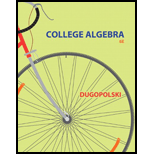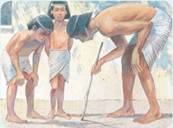
Concept explainers
LINKING concepts... For Individual or Group Explorations

Number Puzzles
Puzzles concerning numbers are as old as numbers themselves. The best number puzzles can be solved without a lot of mathematics, but that does not necessarily make them easy.
a) Think of a number, and add
b) Think of a number between 1 and 10. Think of the product of your number and 9. Think of the sum of the digits in your answer. Think of that number minus 5. Think of the letter in the alphabet that corresponds to the number you are thinking about. Think of a stale that begins with the letter. Think of the second letter in the state. Think of a big animal that begins with that letter. Think of the color of that animal. The color is gray. Explain.
c) Sandy has one quart of grass seed and one quart of sand, each stored in one- gallon containers. Sandy pours a little seed into the sand and shakes well. She then pours the same amount of the mix back into the container of seed so that both containers again contain exactly one quart. Is there more sand in Sandy’s seed or more seed in Sandy’s sand? Explain.
d) In each cell of the second row of the following table put one of the digits 0 through 9. You may use a digit more than once, but each digit in the second row must indicate the number of times that the digit above it appears in the second row.
0 |
1 |
2 |
3 |
4 |
5 |
6 |
7 |
8 |
9 |
Want to see the full answer?
Check out a sample textbook solution
Chapter P Solutions
College Algebra Plus New Mymathlab With Pearson Etext Access Card
- Solve questions by Course Name (Ordinary Differential Equations II 2)arrow_forwardplease Solve questions by Course Name( Ordinary Differential Equations II 2)arrow_forwardInThe Northern Lights are bright flashes of colored light between 50 and 200 miles above Earth. Suppose a flash occurs 150 miles above Earth. What is the measure of arc BD, the portion of Earth from which the flash is visible? (Earth’s radius is approximately 4000 miles.)arrow_forward
- e). n! (n - 1)!arrow_forwardSuppose you flip a fair two-sided coin four times and record the result. a). List the sample space of this experiment. That is, list all possible outcomes that could occur when flipping a fair two-sided coin four total times. Assume the two sides of the coin are Heads (H) and Tails (T).arrow_forwarde). n! (n - 1)!arrow_forward
- Evaluate the following expression and show your work to support your calculations. a). 6! b). 4! 3!0! 7! c). 5!2! d). 5!2! e). n! (n - 1)!arrow_forwardAmy and Samiha have a hat that contains two playing cards, one ace and one king. They are playing a game where they randomly pick a card out of the hat four times, with replacement. Amy thinks that the probability of getting exactly two aces in four picks is equal to the probability of not getting exactly two aces in four picks. Samiha disagrees. She thinks that the probability of not getting exactly two aces is greater. The sample space of possible outcomes is listed below. A represents an ace, and K represents a king. Who is correct?arrow_forwardConsider the exponential function f(x) = 12x. Complete the sentences about the key features of the graph. The domain is all real numbers. The range is y> 0. The equation of the asymptote is y = 0 The y-intercept is 1arrow_forward
 Algebra: Structure And Method, Book 1AlgebraISBN:9780395977224Author:Richard G. Brown, Mary P. Dolciani, Robert H. Sorgenfrey, William L. ColePublisher:McDougal LittellAlgebra & Trigonometry with Analytic GeometryAlgebraISBN:9781133382119Author:SwokowskiPublisher:Cengage
Algebra: Structure And Method, Book 1AlgebraISBN:9780395977224Author:Richard G. Brown, Mary P. Dolciani, Robert H. Sorgenfrey, William L. ColePublisher:McDougal LittellAlgebra & Trigonometry with Analytic GeometryAlgebraISBN:9781133382119Author:SwokowskiPublisher:Cengage

 Holt Mcdougal Larson Pre-algebra: Student Edition...AlgebraISBN:9780547587776Author:HOLT MCDOUGALPublisher:HOLT MCDOUGAL
Holt Mcdougal Larson Pre-algebra: Student Edition...AlgebraISBN:9780547587776Author:HOLT MCDOUGALPublisher:HOLT MCDOUGAL College Algebra (MindTap Course List)AlgebraISBN:9781305652231Author:R. David Gustafson, Jeff HughesPublisher:Cengage Learning
College Algebra (MindTap Course List)AlgebraISBN:9781305652231Author:R. David Gustafson, Jeff HughesPublisher:Cengage Learning





